Archived Water Damage Blog Posts
The Step-by-Step Process of Water Damage Restoration: Restoring Your Property after Water Damage
2/5/2024 (Permalink)
Water damage can wreak havoc on your property, causing structural damage and potential health hazards. A thorough water damage restoration process is essential to ensure the safety of your home and minimize further destruction. In this blog, we will walk you through the step-by-step process of water damage restoration, helping you understand what to expect and how to effectively restore your property.
Emergency Contact and Assessment
The first step is to contact a professional water damage restoration company, such as SERVPRO, who can provide immediate assistance. They will assess the extent of the damage, determining the category and class of water damage to create a tailored restoration plan.
Water Extraction
The removal of excess water is crucial to prevent further damage and mold growth. Professionals will use specialized equipment, such as pumps and commercial-grade extractors, to thoroughly remove standing water from your property.
Drying and Dehumidification
Once the water is extracted, the drying and dehumidification process begins. Industrial-grade air movers and dehumidifiers are strategically placed to facilitate airflow and draw out moisture from walls, floors, and other affected surfaces. This step aims to thoroughly dry the area, reducing the risk of further damage and mold growth.
Cleanup and Sanitization
Water damage often brings along contaminants, bacteria, and odors. The cleanup process involves the removal of damaged materials, such as carpets, drywall, and furniture, followed by thorough cleaning and disinfection. Professionals may utilize antimicrobial treatments to ensure a safe and sanitary environment.
Restoration and Repair
After the affected area is completely dry and sanitized, restoration work begins. This may involve repairing or replacing damaged flooring, walls, insulation, and other structural components. Skilled professionals will work to restore your property to its pre-damage condition, ensuring both functionality and aesthetics.
Monitoring and Preventative Measures
Even after the restoration process is complete, it is essential to monitor for any signs of hidden moisture or mold growth. Professionals may use moisture meters and thermal imaging cameras to detect potential issues. Implementing preventative measures, such as improving drainage, sealing gaps, and addressing plumbing issues, will help minimize the risk of future water damage.
Insurance Claims
Throughout the process, it is essential to document all damage, take photos, and keep detailed records of expenses. This information will be valuable when filing an insurance claim. Communicate with your insurance provider and provide necessary documentation to ensure a smooth and efficient claim process.
Water damage restoration requires a systematic approach to ensure the safety of your property and protect against further damage. By following the step-by-step process of emergency contact and assessment, water extraction, drying and dehumidification, cleanup and sanitization, restoration and repair, monitoring, and insurance claims, you can effectively restore your property to its pre-damage condition and regain peace of mind.
The Invisible Intruder: Unveiling the Dangers of Water Damage in Your Home
10/3/2023 (Permalink)
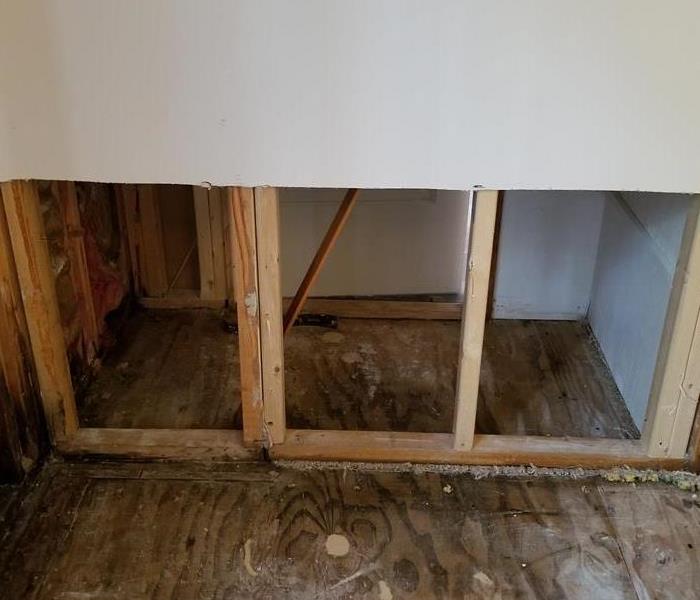 When water damage occurs in your home take proactive steps to prevent further damage.
When water damage occurs in your home take proactive steps to prevent further damage.
Water damage is a common problem faced by homeowners, and it can lead to costly repairs and long-term issues if not addressed promptly. Understanding the different types of water damage and their causes is crucial for prevention and mitigation. In this blog post, we will explore the various types of water damage and what can cause them, empowering you with knowledge to protect your home and minimize potential damage.
Flood Damage
Flood damage occurs when an excessive amount of water enters your home due to natural disasters, such as heavy rainfall, overflowing rivers, or storm surges. Poor drainage systems, inadequate sealing, or living in a flood-prone area can increase the risk of flood damage.
Plumbing Leaks
Plumbing leaks are a common cause of water damage in homes. Leaking pipes, faulty faucets, and damaged water supply lines can result in continuous water flow, leading to structural damage, mold growth, and waterlogged belongings. Aging plumbing systems, improper installation, or lack of regular maintenance contribute to plumbing leaks.
Roof Leaks
Roof leaks occur due to damaged or deteriorated roofing materials. Missing or cracked shingles, damaged flashing, and clogged gutters can allow water to penetrate your roof and seep into your home. Harsh weather conditions, poor maintenance, or improper installation of roofing materials can cause roof leaks.
Appliance Malfunctions
Washing machines, dishwashers, refrigerators, and other appliances that use water can malfunction and cause water damage. Leaking hoses, faulty valves, or broken seals within these appliances can result in water leakage. It is essential to regularly inspect and maintain your appliances to prevent potential damage.
Foundation Issues
Issues with your home's foundation can lead to water damage. Cracks in the foundation, improper grading around the house, or poor drainage can allow water to seep into your basement or crawl space, causing moisture problems and structural damage.
HVAC System Malfunctions
Heating, ventilation, and air conditioning (HVAC) systems can experience malfunctions that result in water damage. Clogged condensate drain lines, leaking pipes, or faulty equipment can cause water to accumulate and seep into your home. Regular maintenance and timely repairs are crucial to ensure proper functioning of your HVAC system.
Water damage can be caused by various factors, ranging from natural disasters to everyday household issues. By understanding the different types of water damage and their causes, you can take proactive steps to prevent or mitigate potential water damage in your home. Regular maintenance, timely repairs, and implementing preventive measures can go a long way in protecting your property and minimizing the impact of water damage. Stay vigilant, address any signs of water damage promptly, and consult professionals when needed to ensure a safe and dry living environment for you and your family.
How Water Damage happens after a fire
3/4/2023 (Permalink)
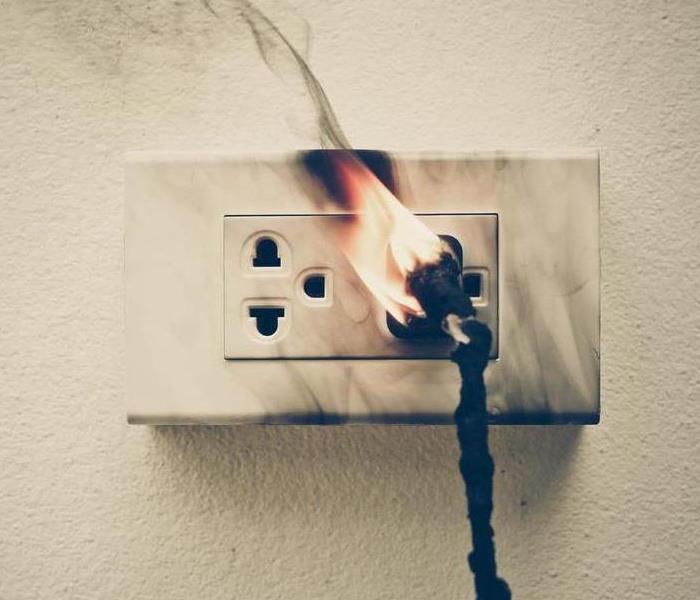 Fire damage can leave your home with water damage and fire. Give the professionals a call today!
Fire damage can leave your home with water damage and fire. Give the professionals a call today!
Water damage is one of the biggest concerns for people after a fire. Most people know that this type of damage happens when water from fire hoses infiltrates their home. However, not everyone realizes that water can cause a variety of problems. In this article, we'll go over some common types of water damage after fires—and how to handle them.
Sources
Water damage can come from a variety of sources. Water damage is not limited to flooding and high-powered hoses. After a fire, water can cause damage in many ways.
Fire sprinkler damage is one way that water causes damage after a fire. When firefighters use their hose lines to put out a fire, they often spray the walls, floors and other surfaces with water as part of their strategy for extinguishing the blaze. The pressure from these powerful streams can cause pipes under your home's foundation or in its walls to burst.
Fire sprinkler damage
Sprinkler systems can also cause extensive water damage that doesn't involve an actual sprinkler going off. When a fire breaks out and alarms go off, the sprinklers are activated automatically by an electronic device. This activates a series of pipes connected to each other and connected to your ceiling or walls. The water is then released into these pipes, where it flows down towards the floor in order to put out any fires on its way down.
The problem with this system is that it often causes damage from leaks in those pipes before they reach their destination and even if there isn't any leakage at all. In fact, even if all your sprinklers stay intact during an emergency situation, there's still a chance that you could end up with serious water damage anyway.
Hose line damage
Firefighters can inadvertently damage hose lines while they are fighting a fire. If they leave the nozzle in one position for too long, it can cause kinks in the line that will prevent water from flowing through it properly. The same thing can happen if firefighters accidentally drag the hose with them when moving around inside a building or vehicle the force of this movement. If you're using an automatic sprinkler system as part of your fire suppression plan, remember that these devices often use large amounts of water within seconds. This rapid influx could potentially overload any nearby hoses which could lead to leaks developing within those systems
Firefighter contamination
Contamination can occur in many ways. When firefighters are fighting a fire or cleaning up afterward, they can get contaminated by walking through the area. If there is still smoke in the air after a fire, it's possible for firefighters to breathe in some of this smoke and become sick from doing so.
Damage from the fire suppression agent
The main water damage culprit after a fire is the fire suppression agent itself. The water used to fight the blaze can seep into your home's structure and cause damage to electronics, appliances and other property. The extent of this damage depends on how much water was used in fighting the fire. If you were able to put out the flames quickly enough before too much water was introduced into your home's structure, then chances are good that there won't be too much damage done. However, if firefighters had to douse your house with copious amounts of water because it took longer than expected for them to get things under control or if they sprayed every room indiscriminately without regard for where their hoses were aimed.
Water damage is not limited to flooding and high-powered hoses. Fire sprinkler damage, hose line damage and firefighter contamination can all cause problems with your home's structure and contents. If you are dealing with any of these issues after a fire, contact us at SERVPRO of Clayton/Ladue for your water restoration clean up.
4 Types of Basement Floods Typically Covered By Homeowners Insurance
12/1/2022 (Permalink)
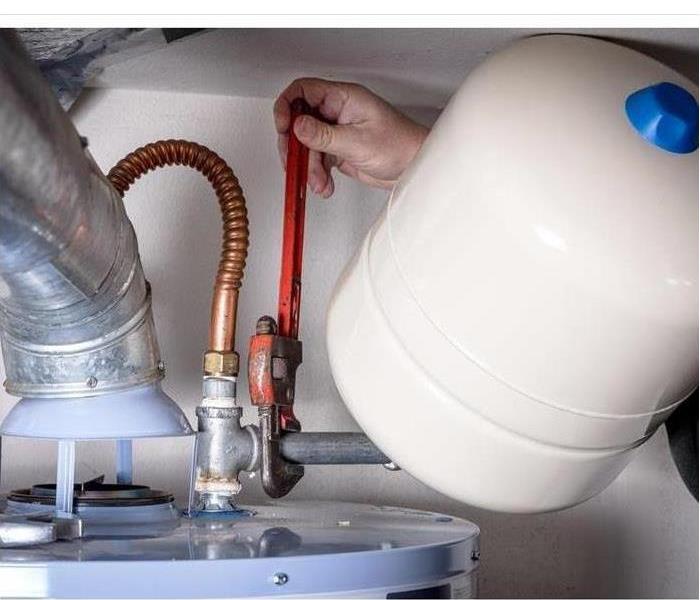 Broken water heater
Broken water heater
Four Common Types Of Basement Floods
You’ve probably heard a horror story from a friend who had the basement flood and couldn’t get reimbursed by the insurance company. While it’s true that certain perils that cause water in the basement are excluded, there are four common types of basement floods that are typically covered by insurance.
1. Burst Pipe
Burst pipes in the basement are a relatively common reason a basement is flooded. When the winter weather sets in, pipes that are not well-insulated can freeze and burst open, causing a deluge of water to pour into the home. These losses are typically covered since it is not an outside source that caused the flood.
2. Overflowing Appliance
Insurance coverage won’t pay for the cost to replace the appliance itself, but will usually cover damage to property or furnishings if appliances overflow. Washer machines are the biggest appliance culprit for a wet basement. Although it isn’t as much water as a pipe or other flowing source, enough sudsy water can ruin flooring or personal property stored nearby.
3. Broken Water Heater
If you have a traditional water heater that stores hot water in a tank, you run the risk of a basement flood if something goes wrong with it. Many times, the bottom of the tank can slowly rot away, but it will go undetected unless regularly monitored by the homeowner. This quick release of hot water can devour anything in its path, but it is considered a covered loss on many insurance policies.
4. Overflowing Sump Pump
Some basements are equipped with a sump pump to draw rain and other water away from the home. However, the pump can stop working if the power fails or the motor burns out, causing a flooded basement. Those kinds of losses are often covered by a special endorsement. Because the water is coming in from outside, it’s a good idea to call flood cleanup experts to sanitize and dry out the affected area to keep your family safe and healthy.
A basement flood is always a nightmare to deal with. However, knowing that some losses are covered by insurance will give you peace of mind.
What To Do After a Sewage Backup?
11/12/2022 (Permalink)
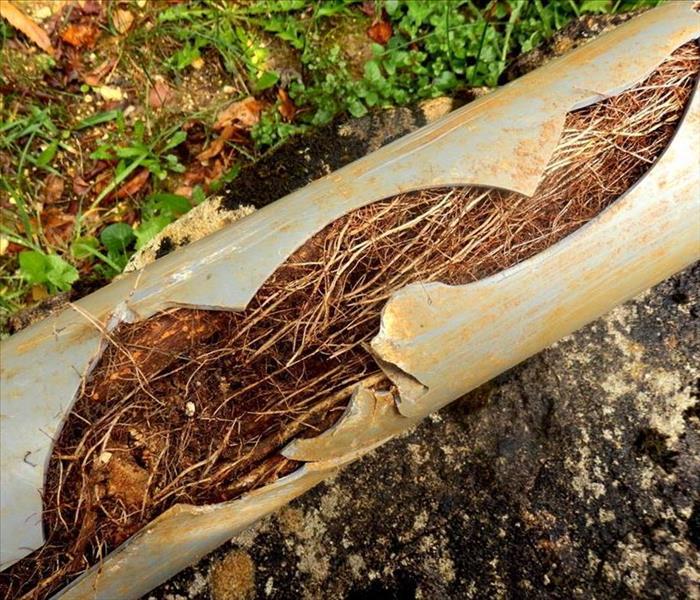 A blocked sewer line can cause sewage backup in your home
A blocked sewer line can cause sewage backup in your home
How Should a Sewage Backup Be Handled?
Sewage backup is a nightmare. The smell is unbearable and can linger for weeks after the cleanup. It's important to know how to address this issue, so you can protect yourself, keep your family safe and get the clean-up done right away.
Protecting Yourself from Sewage
While you're waiting for your home to be cleaned or repaired, it's important to take care of yourself and your family. If you've experienced a sewage backup, you should avoid going into any water that may have been contaminated by wastewater. It is also crucial that you always wear protective clothing while working around areas where sewage has flooded.
How to React to a Sewage Backup
If you have a sewage backup, it's best to keep everyone out of the area until professional help arrives. Do not use any electrical appliances or exposed water sources until they've been thoroughly cleaned and sanitized by a professional. Don't flush toilets or run water as this can cause more damage to your home. It is especially important not to use any fireplaces or wood stoves while there are still standing pools of sewage in your basement because methane gas is produced by decaying organic matter such as fecal matter.
Where Does the Water Come From?
Whether you are dealing with a sewage backup in your home or basement, the source of the problem is usually one of two things: a blocked toilet or drain, or a blocked sewer line. The type of blockage will determine which area needs to be addressed.
If your Ladue, MO home has experienced a sewage backup from one of these sources, there are three ways to proceed: remove the water yourself and clean up as much as possible before calling a professional; hire someone else to do it for you; or call in professionals who can handle both removal and cleanup at once (usually recommended).
How Do You Clean Sewage Damage?
Once you've determined that the area is safe, it's time to start cleaning up. Keep in mind that some materials can be cleaned without special equipment or training. If the affected area is small and accessible, use your regular laundry detergent and hot water to do a quick scrubbing. Use disinfectant on any items that can't be laundered (like carpet), tape off areas not yet cleaned, and wash with soap and hot water before allowing residents back into their homes.
When you're dealing with sewage backup on a larger scale—or if you have more sensitive materials—it's important to bring in specialists who can help with the cleanup process. If possible, keep all tools used in cleanup until they've been disinfected as well; this will prevent cross-contamination between sites throughout your home or business while also reducing risk of disease outbreak among employees who may encounter contaminated items later on down the road.
Why Hire Professionals for Sewer Cleanup?
If you are not a sewer cleaning expert, there are several reasons why hiring a professional company is the best option. They have the equipment and expertise to get the job done right. They can provide guarantees for their work, and they are more likely to follow safety protocols than you would be. Additionally, if a problem arises after they finish their work, they can refer you to other qualified professionals who will fix it at no additional cost.
Prepare for the Cleanup
If you do not have the time and resources to clean up a sewage backup on your own, we recommend calling in a professional. The cleanup process can be quite labor intensive and there are many things that can go wrong if you don't know what you're doing.
Proper preparation is key when cleaning up after a sewage backup. You will want to put down protective tarps or plastic sheeting to prevent contaminants from spreading outside of your home's perimeter, as well as wear rubber gloves and boots during cleanup efforts (your clothes may never smell the same again otherwise!). It's also important that you keep an eye out for any physical injuries sustained by those involved in contact with contaminated water; keep basic first aid supplies on hand so that they can be treated quickly if needed.
It’s important to remember that, even if the cleanup is done well, there will always be some level of inconvenience and frustration. Sewage backups are not something anyone wants to deal with, but they can happen at any time. If your home has been affected by a sewage backup, don’t panic! You can find help with our team by calling (314) 863-4555 or filling out our free quote form online.
How Contaminated is Your Flood Water?
8/15/2022 (Permalink)
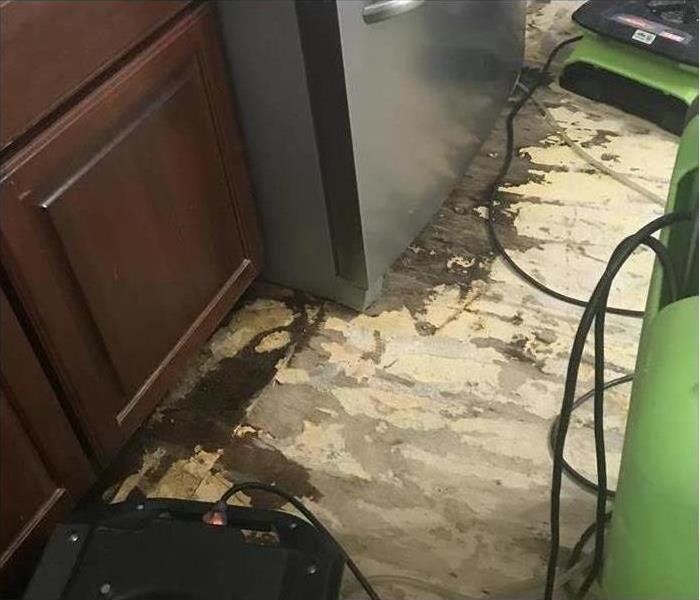 Refrigerator line breaks causing water damage.
Refrigerator line breaks causing water damage.
Types Of Water Damage
When contaminated water enters your home in University City, MO you may begin wondering how dangerous it is to wade into the water. This can depend on your supply line, where the water came from, and other factors. As complex as this can be, there are three main categories of water:
- Clean Water
- Gray Water
- Black Water
While these may seem like meaningless titles, these categories can give you a good idea of how dangerous standing water is.
Clean Water
Clean water, which is also called, “White Water,” is generally considered safe. This is the type of water that you may shower, cook, and clean with. You might face floodwater in this category if a pipe inside your home bursts and does not contact anything else. Generally speaking, you can be safe from contamination when dealing with this type of water.
Gray Water
This water is slightly contaminated, but not necessarily dangerous. That means that gray water may have such particles as human hair, oils, and soap. The important thing is that gray water has not contacted solid human waste. This type of water may come from an overflowing tub or sink, for example.
Black Water
The most important thing about this type of water is that it has encountered solid human waste. Thus, it could be contaminated with harmful bacteria, parasites, toxins, and other dangerous particles. If your toilet overflows or your sewage backs up, you should not go near it. Many people are surprised to learn that flood water that enters your home from outside after a storm is also black water. It can become contaminated water when sewage backs up from the flooding.
No matter what kind of water damages your home in University City, MO it’s essential to call a professional restoration company to assist you. All kinds of water can cause mold, and a restoration company can help.
How To Handle a Flooded Basement
8/1/2022 (Permalink)
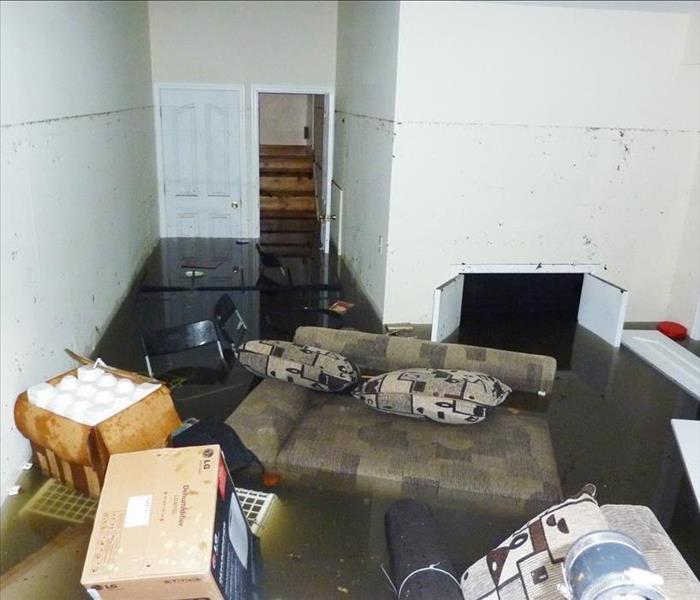 A flooded basement in Richmond Heights, MO.
A flooded basement in Richmond Heights, MO.
What to Do If Your Basement Is Flooded
Discovering you have a basement flood in your Richmond Heights, MO home can be an unpleasant surprise. Heavy rains, a broken water line or a sudden spring thaw can result in basement flooding and cause damage to the floors, walls and any items you might have stored there. If you find yourself facing a flooded basement, there are a few steps you can take to resolve the problem, no matter the cause.
Call for Mitigation Services
If you house your washer, dryer or any other electrical appliances in your basement, the safest way to approach a flood is to call a professional flood cleanup and restoration service. Not only can this type of company remove the water, but their knowledgeable techs are trained to deal with any electrical dangers the flooding might have caused. They can also offer mitigation services to deal with the worst of the damage right away and prevent water from entering other areas of your home.
Take Inventory of Damaged Items
Once it is safe to enter the basement, it is a good idea to take an inventory of any damaged items, from furniture to toys to stored seasonal clothing. Ask your flood cleanup technicians if you can move any boxes or storage tubs so you can assess the damage. Making this list might help you file a more detailed insurance claim.
Inquire About Repairs
If a plumbing mishap caused your basement to flood, you can ask your restoration experts about pipe repair and what they can do about any damage to the walls or floor. If your basement contains any drywall or insulation, affected sections might have to be cut away and removed. Ask for an estimate and a timeline for the repairs so you can have some idea about when you can start using your basement again.
When flooding affects your Richmond Heights, MO home's basement, it can be a stressful experience. However, knowing how to proceed can help you feel confident when it comes to arranging for water removal and necessary repairs.
5 Things To Know About Water Damage
7/2/2022 (Permalink)
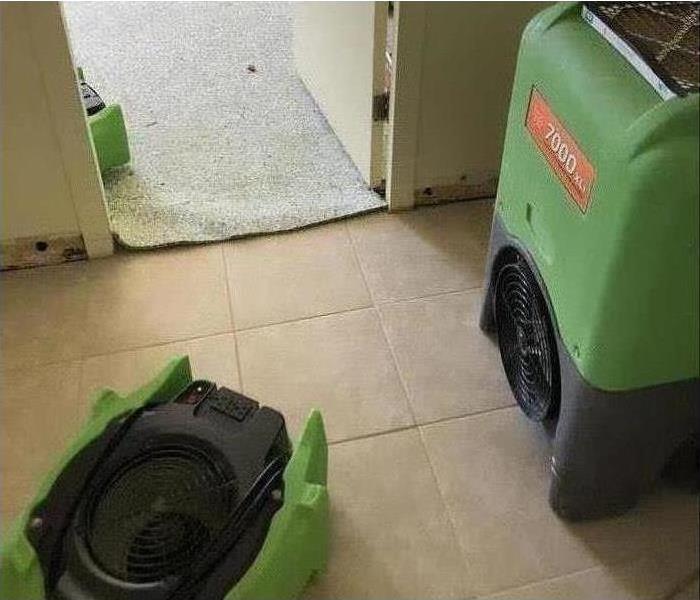 If you have water damage in your home a local water damage restoration service can help.
If you have water damage in your home a local water damage restoration service can help.
Understanding Water Damage
When there’s a pipe burst in your Ladue, MO, home you may be worried about water damage. Understanding water damage can help you deal with it quickly before additional problems occur. Here’s what you should know.
1. It Should Be Cleaned Up Quickly
The first thing that should be understood about flood water is that the water should be cleaned up as quickly as possible. This can help prevent it from seeping in and causing long-term damage.
2. It Can Lead to Long Term Problems
If left to sit too long water can cause additional damage to your home. These include crumbling drywall, mold problems, warped wood, cracked tile, and rust in metal components.
3. It Can Occur in a Number of Ways
Water damage can start with a number of sources. These include a pipe burst, water line leak, roof damage, storm flooding, or a sewer backup. Knowing the source of the damage is an important part of the cleanup process as it can help the restoration team determine the necessary repair steps.
4. A Professional Can Help
If you have water damage in your home a local water damage restoration service can help. These professionals have the training needed to deal with multiple forms of damage that can result from flooding. With a little time, they can have your home looking “Like it never even happened.”
5. Items Should Be Cleaned Too
You may also want to clean any affected items. The exact method will depend on the material type, but a restoration service can help with this as well. They can even help dry damaged paper goods such as books.
After a pipe burst, leaking roof, stormwater, or other water damage in your home, it’s best to contact a professional to help clean up the water as quickly as possible. Doing so can help prevent lot of term problems. Affected items should be cleaned as well.





 24/7 Emergency Service
24/7 Emergency Service






